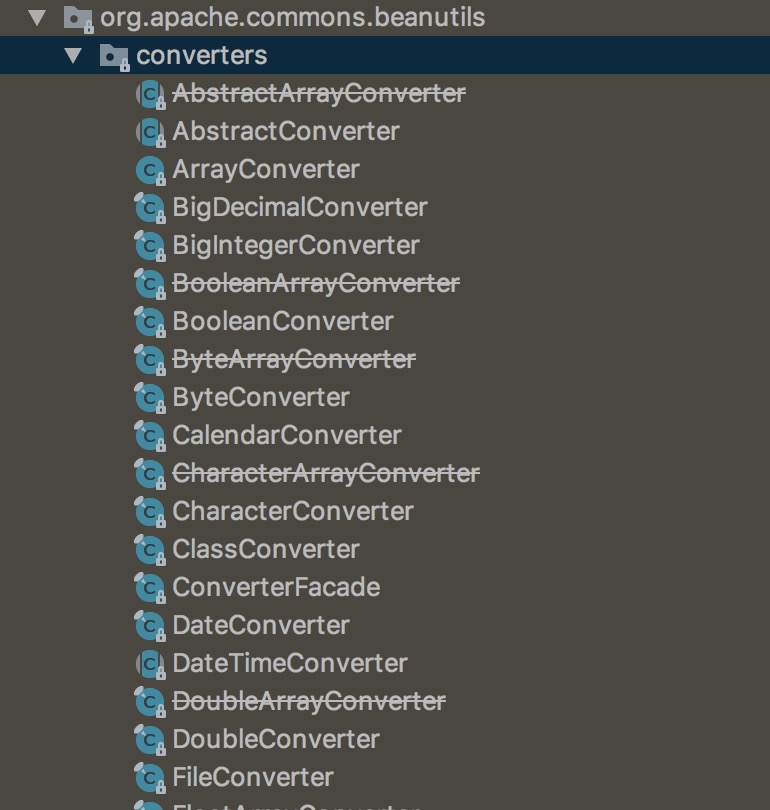淺談反射效能
前陣子有個使用者呼叫劵列表一直超時,後面經過效能排查:發現這個使用者下面有8000多張劵,db查詢花了10多毫秒。但是物件從entity到dto的複製卻花了幾百毫秒,後面定位到效能瓶頸是出現在了ApacheBeanUtils的org.apache.commons.beanutils.BeanUtils#copyProperties方法上面,複製8000多個物件花了幾百毫秒。
通過閱讀原始碼發現了org.apache.commons.beanutils.BeanUtils#copyProperties的時間主要花在兩個地方:1、反射建立物件 2、值複製的型別轉換。 原來ApacheBeanUtils提供的copyProperties除了支援相同型別相同名稱的欄位複製以外,還支援基本型別到包裝型別,包裝型別到基本型別, Date轉string,long 這些功能,只要欄位名稱相同ApacheBeanUtils會盡可能進行型別轉換然後複製。ApacheBeanUtils的值複製是通過conveter進行的。有興趣的同學可以中央倉庫下載相應的原始碼去了解。
beanutils --> <dependency> <groupId>commons-beanutils</groupId> <artifactId>commons-beanutils</artifactId> <version>1.9.1</version> </dependency>
具體包路徑是org/apache/commons/beanutils/converters下面可以看到各種各樣的converters。

後面也查明瞭效能瓶頸主要卡在了型別轉換這裡。
上面提到了org.apache.commons.beanutils.BeanUtils#copyProperties的時間主要花在兩個地方:1、反射建立物件 2、值複製的型別轉換。那反射對效能的影響到底有多大呢,下面我們來探討一下。
反射是java語言的一個很重要的特性,它可以遍歷物件的屬性,方法。甚至動態去修改物件的值和行為,突破私有欄位的保護機制,訪問並修改物件的私有欄位。很多底層的框架的都利用了反射的特性, 比如spring的IOC就是利用了反射。
下面來分析一下的反射的方法呼叫:
這一段程式碼,通過列印異常的堆疊,得到反射的方法呼叫鏈
public class ReflectTest { public void target(int i ){ new Exception("#" + i).printStackTrace(); } public static void main(String[] args) throws Exception { ReflectTest instance = ReflectTest.class.newInstance(); Method method = ReflectTest.class.getMethod("target", int.class); method.invoke(instance,1); } }
java.lang.Exception: #1
at ReflectTest.target(ReflectTest.java:7)
at sun.reflect.NativeMethodAccessorImpl.invoke0(Native Method)
at sun.reflect.NativeMethodAccessorImpl.invoke(NativeMethodAccessorImpl.java:62)
at sun.reflect.DelegatingMethodAccessorImpl.invoke(DelegatingMethodAccessorImpl.java:43)
at java.lang.reflect.Method.invoke(Method.java:498)
at ReflectTest.main(ReflectTest.java:13)
其中NativeMethodAccessorImpl表示呼叫的是本地的C++方法。所以我們知道了反射的方法呼叫是會經過java -> c++ ->java 的轉換,所以這個過程看上去的確是比較耗時。。。。這裡簡稱這個為本地實現
既然本地實現的方法可能會比較耗時那麼有沒有不用呼叫本地方法實現呢?其實是有的。在預設的JAVA反射機制裡面如果反射的方法的呼叫次數超過一個閥值15,則會用有動態生成的位元組碼去代替本地的C++方法呼叫,即動態實現。
看程式碼:
public class ReflectTest { public void target(int i ){ if(i % 10 == 0) { new Exception("#" + i).printStackTrace(); } } public static void main(String[] args) throws Exception { ReflectTest instance = ReflectTest.class.newInstance(); Method method = ReflectTest.class.getMethod("target", int.class); int i = 0; while(i < 30) { method.invoke(instance, i++); } } } java.lang.Exception: #0 at ReflectTest.target(ReflectTest.java:7) at sun.reflect.NativeMethodAccessorImpl.invoke0(Native Method) at sun.reflect.NativeMethodAccessorImpl.invoke(NativeMethodAccessorImpl.java:62) at sun.reflect.DelegatingMethodAccessorImpl.invoke(DelegatingMethodAccessorImpl.java:43) at java.lang.reflect.Method.invoke(Method.java:498) at ReflectTest.main(ReflectTest.java:16) java.lang.Exception: #10 at ReflectTest.target(ReflectTest.java:7) at sun.reflect.NativeMethodAccessorImpl.invoke0(Native Method) at sun.reflect.NativeMethodAccessorImpl.invoke(NativeMethodAccessorImpl.java:62) at sun.reflect.DelegatingMethodAccessorImpl.invoke(DelegatingMethodAccessorImpl.java:43) at java.lang.reflect.Method.invoke(Method.java:498) at ReflectTest.main(ReflectTest.java:16) java.lang.Exception: #20 at ReflectTest.target(ReflectTest.java:7) at sun.reflect.GeneratedMethodAccessor1.invoke(Unknown Source) at sun.reflect.DelegatingMethodAccessorImpl.invoke(DelegatingMethodAccessorImpl.java:43) at java.lang.reflect.Method.invoke(Method.java:498) at ReflectTest.main(ReflectTest.java:16)
看到最後一段輸出已經沒有了NativeMethodAccessorImpl的呼叫,取而代之的是GeneratedMethodAccessor1的呼叫。
這裡會有個疑問就是既然動態實現不需要經過JAVA到C++的轉換那為什麼一開始不用動態實現而是用本地實現呢?那是因為JAVA認為大部分的反射方法呼叫一般只調用一次或者幾次,而動態實現的第一次呼叫是要生成位元組碼,這個是很耗費時間的,效能是本地實現的三到四倍。
ok,那現在我們知道了反射的方法呼叫過程。那具體是怎麼呼叫的呢, 這就需要深入到位元組碼的裡面去看一下。把上面的程式碼改一下:
import java.lang.reflect.Method; public class ReflectTest { public void target(int i ){ new Exception("#" + i).printStackTrace(); } public static void main(String[] args) throws Exception { ReflectTest instance = ReflectTest.class.newInstance(); Method method = ReflectTest.class.getMethod("target", int.class); int i = 128; method.invoke(instance, i); } }
編譯成class檔案後用javap 命令檢視,具體命令是: javap -p -v ReflectTest
public static void main(java.lang.String[]) throws java.lang.Exception; descriptor: ([Ljava/lang/String;)V flags: ACC_PUBLIC, ACC_STATIC Code: stack=6, locals=4, args_size=1 0: ldc #11 // class ReflectTest 2: invokevirtual #12 // Method java/lang/Class.newInstance:()Ljava/lang/Object; 5: checkcast #11 // class ReflectTest 8: astore_1 9: ldc #11 // class ReflectTest 11: ldc #13 // String target 13: iconst_1 14: anewarray #14 // class java/lang/Class 17: dup 18: iconst_0 19: getstatic #15 // Field java/lang/Integer.TYPE:Ljava/lang/Class; 22: aastore 23: invokevirtual #16 // Method java/lang/Class.getMethod:(Ljava/lang/String;[Ljava/lang/Class;)Ljava/lang/reflect/Method;
看到main方法的19:getstatic #15 和 23:invokevirtual
再結合Methond.invoke方法描述:public Object invoke(Object obj, Object... args)
所以我們知道 Method.invoke 是一個變長引數方法,所有引數都會封入一個Object[] args的陣列中。 則傳入的引數int i 會進行一次裝箱的操作。其原因是因為Object[] args不支援基本型別的儲存,如果方法的呼叫次數非常頻繁這裡就存在的兩個效能的隱患:
第一:頻繁的裝箱操作影響效能
第二:大量的裝箱物件導致GC
下面我們驗證一下:
import java.lang.reflect.Method; public class ReflectTest { public void target(int i ){ // new Exception("#" + i).printStackTrace(); } public static void main(String[] args) throws Exception { ReflectTest instance = ReflectTest.class.newInstance(); Method method = ReflectTest.class.getMethod("target", int.class); for(int i = 0; i < 30000000; i++) method.invoke(instance, i); } } 虛擬機器引數加上: -XX:+PrintGc [GC (Allocation Failure) 33280K->504K(125952K), 0.0019714 secs] [GC (Allocation Failure) 33784K->536K(125952K), 0.0008074 secs] [GC (Allocation Failure) 33816K->472K(125952K), 0.0006326 secs] [GC (Allocation Failure) 33752K->472K(159232K), 0.0010250 secs] [GC (Allocation Failure) 67032K-fnj>504K(159232K), 0.0007691 secs] [GC (Allocation Failure) 67064K->472K(221696K), 0.0011877 secs] [GC (Allocation Failure) 133592K->424K(221696K), 0.0047642 secs] [GC (Allocation Failure) 133544K->424K(354816K), 0.0003638 secs] [GC (Allocation Failure) 266664K->424K(354816K), 0.0006019 secs] [GC (Allocation Failure) 266664K->424K(514560K), 0.0004477 secs] [GC (Allocation Failure) 426408K->424K(514560K), 0.0006819 secs] [GC (Allocation Failure) 426408K->424K(770560K), 0.0003766 secs]
在呼叫次數非常多的情況的確認會引發GC,所以反射的方法呼叫有時確實會很影響效能。。。
下面我們就用JMH(一個性能基準測試框架)來進行一個量化分析:
ReflectTest#target改成:
public void target(int i ){ for (int j = 0; j < 10000; j++) i++; }
然後執行下面程式:
import org.openjdk.jmh.annotations.Benchmark; import org.openjdk.jmh.annotations.BenchmarkMode; import org.openjdk.jmh.annotations.Mode; import org.openjdk.jmh.annotations.OutputTimeUnit; import org.openjdk.jmh.annotations.Scope; import org.openjdk.jmh.annotations.Setup; import org.openjdk.jmh.annotations.State; import org.openjdk.jmh.runner.Runner; import org.openjdk.jmh.runner.RunnerException; import org.openjdk.jmh.runner.options.Options; import org.openjdk.jmh.runner.options.OptionsBuilder; import java.lang.reflect.InvocationTargetException; import java.lang.reflect.Method; import java.util.concurrent.TimeUnit; @BenchmarkMode(Mode.AverageTime) @OutputTimeUnit(TimeUnit.MICROSECONDS) @State(Scope.Thread) public class ReflectTestBenchMark { private ReflectTest reflectTest; private Method method; private ReflectTest instance; @Setup public void setUp() throws NoSuchMethodException, IllegalAccessException, InstantiationException { reflectTest = new ReflectTest(); method = ReflectTest.class.getMethod("target",int.class); instance = ReflectTest.class.newInstance(); } @Benchmark public void testNormalInvoke(){ for(int i = 0; i < 100000; i++){ reflectTest.target(i); } } @Benchmark public void testReflectInvoke() throws InvocationTargetException, IllegalAccessException { for(int i = 0; i < 100000; i++){ method.invoke(instance,i); } } public static void main(String[] args) throws RunnerException { Options opt = new OptionsBuilder() .include(ReflectTestBenchMark.class.getSimpleName()) .forks(1) .warmupIterations(5) .measurementIterations(5) .build(); new Runner(opt).run(); } }
測得結果如下:
Benchmark Mode Cnt Score Error Units ReflectTestBenchMark.testNormalInvoke avgt 5 0.001 ± 0.001 us/op ReflectTestBenchMark.testReflectInvoke avgt 5 382.222 ± 14.693 us/op
這裡的結果是單次testNormalInvoke,testReflectInvoke平均呼叫時間,單位是微秒。上面顯示了100000次的target方法呼叫,反射的方法呼叫只比沒有用反射的呼叫慢了大概382us,還不到1ms, 看似真的影響不大。
不過具體問題還是具體分析吧,只有瞭解原理遇到問題時才能有效的快速定位到原因~。
